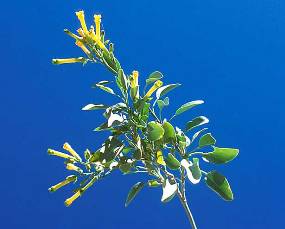
The violet-crowned hummingbird (Amazilia violiceps)is a common visitor to tree morning glory and tree tobacco in tropical deciduous forest. Unlike most other hummingbirds in Sonora, the coloration of males and females are very similar. Photo: K. Krebbs at Rancho La Mula, Sonora. |
 Pineapple sage (Salvia elegans) is abundant at El Aguajito, and hummingbirds love it. Pineapple sage (Salvia elegans) is abundant at El Aguajito, and hummingbirds love it. |

The white-eared hummingbird (Hylocharis leucotis) is the most common hummingbird in the pine-oak forest in the Yécora area in eastern Sonora. It is especially common in the pineapple sage patch at El Aguajito. In winter, most white-ears migrate to lower elevations or southward in the Sierra Madre Occidental to warmer areas where plants continue to flower. One hardy individual was seen visiting pineapple sage flowers on a cold, windy morning in December with snow on the ground. Photo: K. Krebbs. |

Scarlet betony (Stachys coccinea) is another typical hummingbird flower. |

The blue-throated hummingbird (Lampornis clemenciae) is the largest hummingbird in Sonora where it is typically found in pine-oak forest from March to September during the breeding season. Presumably, they migrate southward through the Sierra Madre Occidental to winter farther south. Blue-throats commonly visit the tree tobaccos at El Aguajito. Photo: J. Flynn. |

Barranca El Salto (1900 to 2100 m elevation) is a steep canyon on the western edge of Mesa del Campanero west of Yécora in eastern Sonora. The vegetation is a mixed-conifer forest with one of the few stands of Durango fir (Abies durangensis) in Sonora. |

Tree tobacco (Nicotiana glauca) is native to South America. Although it is basically an herb, well-watered plants become tree-sized. Since the completion of MEX 16 in 1992, it has colonized disturbed soils on roadsides from 500 to 1700 m elevations in both tropical and montane vegetation. Unlike many non-native species, the tree tobacco is beneficial to wildlife, attracting many hummingbirds to its yellow flowers which are borne year-round.
|

The broad-tailed hummingbird (Selasphorus platycercus) is a long distance migrant that passes through Sonora in montane conifer forest habitats. It’s wing feathers produce a distinctive shrill sound that announces its presence in the forest. Photo: K. Krebbs at ASDM. |

The southward migration of the rufous hummingbird (Selasphorus rufus, above, feeding on Salvia elegans) in the summer and fall has two distinctive phases. Beginning in July, large numbers of adults including mature males move through western New Mexico and eastern Arizona south through the main Sierra Madre Occidental in Chihuahua. Later in late August through early October, a second wave of rufous hummingbirds, mostly females and young males passes though southern Arizona and eastern Sonora in both lowland and montane habitats. Along the Tónichi-Yécora transect in eastern Sonora, late summer migrants were common in pine-oak forest at El Aguajito and in Barranca El Salto. Photo: K. Krebbs. |

Broad-billed (Cynanthus latirostris, shown here) and Costa’s (Calypte costae) hummingbirds were among the eleven species of hummingbirds observed in Barranca El Salto. The presence of typical lowland species at 1900 m elevation in mixed-conifer forest is very interesting. Apparently, they migrated upward from the tropical deciduous forest to take advantage of the abundant Texas betony (Stachys coccinea) flowers. Photo: J. Flynn at ASDM. |

There are many splendid hummingbird flowers in this region. Bat-faced monkey flower (Cuphea llavea) is among the most brilliant reds anywhere. Photos: Mark Dimmitt; inset: T.R. Van Devender. |
|